It’s hard to think about Marigolds and not imagine the warmth of summer, and the brilliance of the sun. Although historically this plant has had different meanings, the display of vibrant coloured blooms can make any garden more cheerful, especially since they bloom most of the year.
In our guide, we take a look at the different varieties of the marigold flower, when and how to plant them, how to care for them, and of course how to propagate from both cuttings and seed.
More...
Family: | Asteraceae |
|---|---|
Genus: | Tagetes |
Common Name: | Marigold |
Plant Type: | Flower |
Sun Exposure: | Full Sun, Part Sun |
Soil type: | Well-draining |
Soil Ph: | Neutral |
Bloom Time: | Spring, Summer, Autumn |
Flower Colour: | Orange, Red, White, Yellow |
Maintenance level: | Low |
Poisonous to pets: | Yes |
Marigolds Plant Details
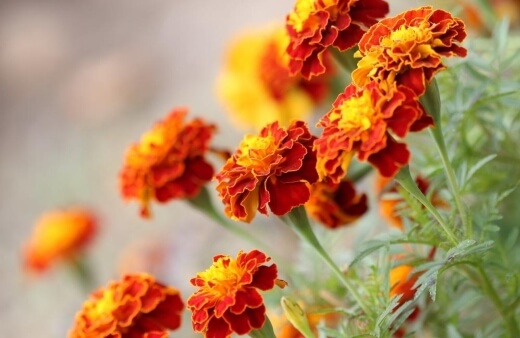
Marigolds are indigenous to Mexico and Guatemala and were discovered in the early 16th century. When they were brought to Europe and Northern Africa in the late 16th century they quickly started popping up in local gardens. The genus name, Tagetes, comes from a mythical Etruscan deity.
This plant falls into two categories based on their scientific name. The first category includes varieties from the Calendula genus, which is a Latin name meaning “little clock”.
The second group of marigolds are from the Tagetes genus. This name comes from a religious prophet named Tages that influenced Etruscan culture. The common name Marigold comes from the plant’s use as an offering to the Virgin Mary instead of using gold coins.
In the Victorian era, marigolds were considered a symbol of despair and grief. The more modern meanings of the marigold flower focus on the sunny colour and beauty of the plant, offering a meaning of optimism and success instead.
Marigold plants were carried as love charms or spells in the Middle Ages by those who wanted to attract a partner.
Different Types fo Marigold
Marigolds produce flowers that look a bit like daisies or carnations. There are about 50 different species, but most marigolds we see in the garden are one of the following:
Tagetes erecta
(African marigold, American marigold, or Mexican marigold)
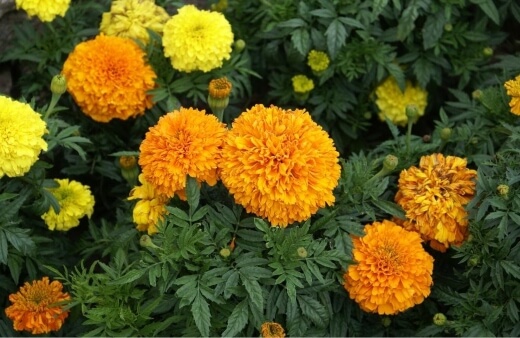
This species is the tallest and most upright marigold, and produces large, full flowers. They’re native to Mexico and Central America and will happily thrive in drought-like conditions.
Tagetes patula (French marigold)
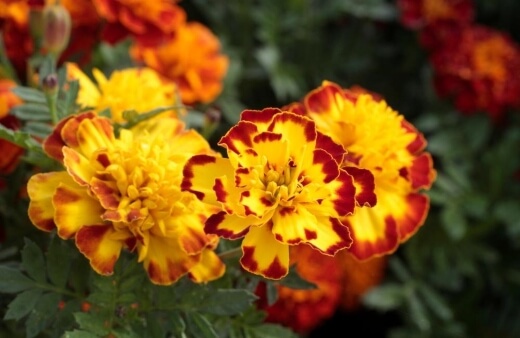
French marigolds are smaller, bushier, and more compact than T. erecta, and are often wider than they are tall. Their flowers tend to be plain and they do well in rainy conditions more than the other Tagetes species.
Tagetes tenuifolia (Signet marigold)
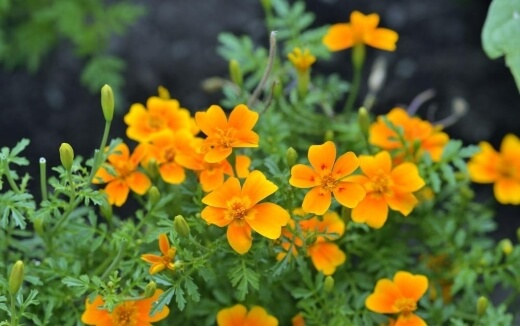
These petite marigolds like hot and dry sites and make a great edging plant.
Calendula officinalis (Pot marigold or English marigold)
Originating from southern Europe, this “marigold” is actually not a true marigold. It has bright flowers that are edible and have a tangy, peppery taste.
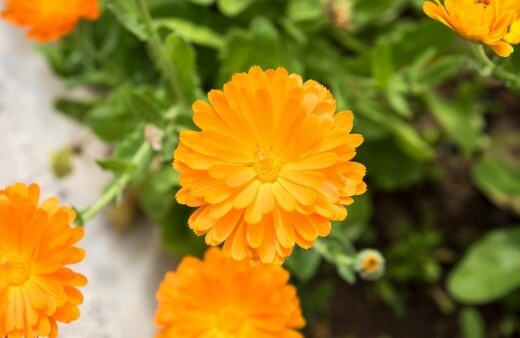
Marigold flowers come in a range of colours and sizes. French marigold varieties tend to be smaller than American/African varieties. Here are some of the features that make up the different varieties.
French Marigolds
- ‘Little Hero’ Series: large, double carnation flowers in 7 colour combinations of maroon, orange, and yellow.
- ‘Hero’ Series: double carnation, large flowers in 7 different combinations of yellow, orange, and maroon.
- ‘Bonanza’ Series: double carnation flowers in 5 different combinations of yellow, orange, and maroon.
- ‘Aurora’ Series: wide petals, anemone-like flowers in shades of maroon, yellow, and orange.
- ‘Janie’ Series: early blooming and perfect for container growing. Double carnation type flowers in 6 different combinations of yellow, orange, and maroon.
- ‘Boy O’ Boy’ Series: abundant flowering plants with flowers in shades of maroon, yellow, and orange
American/African Marigolds
- ‘Jubilee’ Series: dense, double flowers in shades of yellow and orange.
- ‘Gold Coin’ Series: large double blooms in gold, yellow, and orange.
- ‘Safari’ Series: flat-topped, large flowers in shades of maroon, yellow, and orange.
- ‘French Vanilla’: wide flowers in pure creamy white with minimal scent.
How to Grow Marigolds
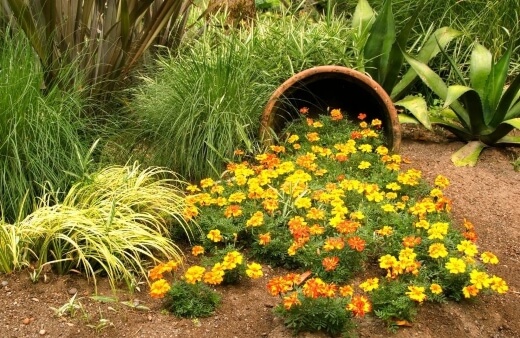
Marigolds love full sunshine and can handle very hot summers. The African and signet marigolds are drought tolerant, while the French marigolds are more tolerant of wet conditions.


Get Your Free Guide:
Master Growing Australian Natives eBook
A Must Have Complete Guide for Every Australian Garden
Get Your Free Guide:
Master Growing Australian Natives eBook
A Must Have Complete Guide for Every Australian Garden
These plants can grow in almost any soil, but do best in fertile, well-drained soil. You can prepare the soil by digging down about 15cm to loosen it and then mix in compost to make it fertile and improve soil consistency.
Planting Marigolds
When to Plant Tagetes
Young French and signet marigolds can be planted from spring through to the middle of summer. The tall African variety should be planted straight away in the spring because they are slower to mature and produce flowers.
You can sow seeds directly into the garden once the soil is warm in the spring. You can start seeds indoors if you prefer, but they germinate so easily outside so it doesn’t really make a difference.
The exception is African marigold, which can be started indoors for about 4 to 6 weeks. This plant sprout within a week in warm weather and usually produce flowers in about 8 weeks.
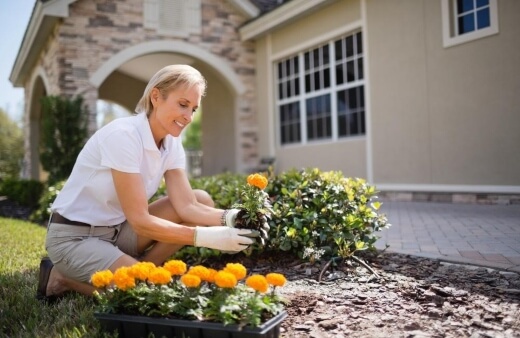
How to Plant Marigold
If your soil is lacking nutrients, you can add some slow-release fertiliser, preferably organic, into the planting hole. A 5-10-5 would be a good option.
Wet the soil, then sow the seeds 2.5cm apart and no more than 2.5cm deep. Space French and signet types 20 to 25cm apart. The larger African marigolds should be at least 25 to 30cm apart.
If you are planting in containers, use a soil-based potting mix. We have gathered the best soil for containers here.
You can mix in a slow-acting granular fertiliser at planting time. Make sure you space the plants properly as marigolds grown in containers can become crowded.
Marigolds as Companion Plants
Marigolds are well respected as important companion plants all over the garden. Growing marigold in or next to your vegetable garden for example can be beneficial in many ways.
This plant tend to guard your veggies from nibbling rabbits and deer, since they don’t like the scent. Flowers of Marigold attract bees and beneficial insects like ladybugs. They also repel unwanted visitors like whiteflies, cabbage worms and tomato hornworms.
French marigolds are the best choice for this as well as protecting your garden from harmful nematodes that live in the soil and attack the roots of garden vegetables.
The kind of crops most affected by these microscopic worms are tomatoes, cucumbers, strawberries, snap beans, squash, onions, and garlic.
Just something to consider, your marigolds’ water needs may be different than the vegetables they are planted with so you might need to water them separately.
Caring for Marigolds
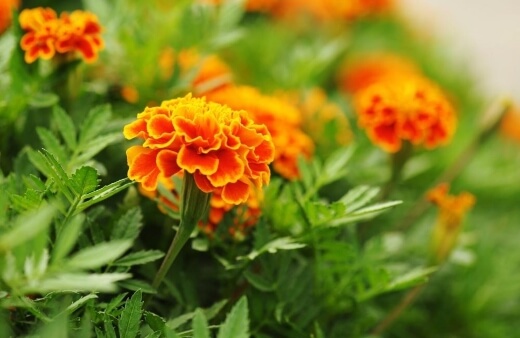
Marigolds are very low-maintenance once they’re established, and generally quite pest-free. They can bloom almost non-stop and will keep going all summer, but in order to maintain the flowering, you do need to keep your plant deadheaded.
Flowering may slow down during the heat of summer and then increases when cooler weather arrives.
Sunlight Needs
To achieve the most flowers and the healthiest plant, plant your marigolds in full sun. Shady conditions cause the plant to become leggy and produce less flowers.
Best Soil for Marigold
Marigolds are not fussy about their soil. Any good garden soil and a little water during dry periods will keep them on track. Just ensure the soil is not too acidic.
The soil pH should be roughly neutral, from 6.0 to 7.0. You also don’t need soil rich in organic matter. This plant actually grow better in a leaner soil.
How to Water Marigold
When you first plant your marigold seeds or plants, make sure they get regular water. They shouldn’t be in dry soil for more than a couple of days. If the weather is hot and sunny, water new plants every day.
Once they’ve established a good root system, they will be more drought-tolerant, but for the best blooms, give marigolds a weekly watering. Don’t water from overhead but rather at the base of the plant.
Temperature and Humidity
Marigolds love heat which is why they thrive in summers. They can handle a wide range of humidity levels, but they may get powdery mildew in damp or humid summers.
If you plant in full sun and allow room for airflow you shouldn’t have a problem. This plant prefer relatively dry air.
Fertilising Marigold
Marigolds don't really need fertiliser unless your soil is extremely poor. Don’t fertilise them during growth as too much nitrogen will stimulate lush leaves rather than flowers.
Add a layer of mulch between plants to control weeds and keep the soil moist. This is especially important when the plants are young. We’ve learned a thing or two about types of mulch for the garden and when and how to use it. Check out our ultimate mulch guide.
How to Prune Marigold
The best thing you can do to keep marigolds in flower is to deadhead the flowers on a regular basis. Deadheading is simply removing faded flowers by pinching off the flower head.
This actually encourages the plant to produce more flowers instead of wasting energy on forming seeds. Marigolds also look better after deadheading. The thick, double flowerheads of the African marigolds tend to rot in wet weather.
Not sure when to start the deadheading process? When a flower starts to go bad, cut its stem back to the nearest set of leaves. Cutting back the early flower buds will cause a marigold plant to spread out and produce a much more generous season of flowering.
Regular deadheading will keep your marigolds producing new flowers well into autumn. Marigolds are true annuals that can be pulled out and thrown away when cold temperatures finally cause them to die.
You can leave a few plants to self-seed in the garden. Birds don't actually eat marigold seeds but they tear apart the flower heads, which helps the self-seeding process.
How to Propagate Marigolds
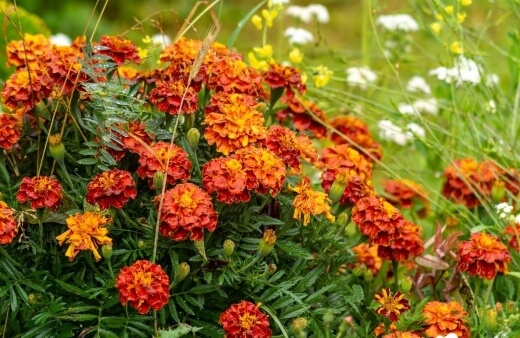
Propagation Marigold from a Cutting
This is actually quite a simple process. Here are the steps to follow:
Use sharp scissors or secateurs (get the best secateurs available online here) to cut off pieces of green stem that are about 10cm in length. The stems should be without flowers or flower buds. Pull off all leaves from the lower half of the cutting.
Dip the cutting in rooting hormone and plant it about 5cm deep in a small pot filled with a blend of potting soil, sand, and perlite. Tap down the potting mix firmly around the cutting and water.
Place the pot in a loosely tied plastic bag, which creates a greenhouse effect. The pot should be in a warm, bright area, but out of direct sunlight. Every four or five days, lightly water the potting mix.
When the cuttings have rooted after a few weeks, you can transplant the rooted cuttings into larger pots filled with ordinary potting soil. You want them to be well established before planting in the garden.
Marigold Propagation from Seed
Marigolds are also very easy to grow from seed. The seeds are large and easy to handle. You can start off with the seeds indoors but marigolds germinate quickly outdoors if you sow them directly into garden soil.
Often last year's marigolds self-seed so quickly you might not even need to plant new ones once the process is in bloom.
If you are going to start marigold seeds indoors, sow them on the surface of a tray or small pot filled with ordinary commercial potting soil that’s slightly damp.
Cover the seeds with a thin layer of vermiculite and then cover the tray or pot with plastic. Place it in a warm location. Light is not needed until the seeds germinate and sprout.
When the seeds sprout after four or five days, remove the plastic and move the container to a place that gets four or five hours of good light daily. Even artificial light is fine.
Keep the potting mix moist and to avoid damping-off fungus, water from below by allowing the pot to absorb water from a tray. When the seedlings are producing lots of new leaves they are ready to transplant outdoors.
Pests and Diseases that Affect Marigolds
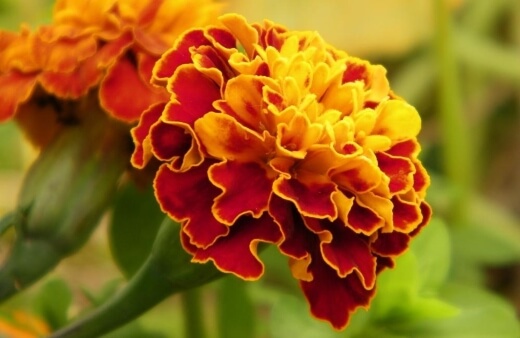
Marigolds have very few pests or problems, but be on the lookout for spider mites and aphids that sometimes infest the plants. If you do find these pests, a spray of water or using an insecticidal soap for a week or two should sort out the problem.
Marigold Fungal Diseases
Sometimes marigolds are affected by fungal diseases such as powdery mildew if conditions are too wet. A good way to prevent this is to avoid getting water on the marigolds’ leaves and plant in well-drained soil. Also do your best to manage weeds.
Marigolds are easy to grow from seeds, but sometimes the seedlings die off quickly just as they are starting to grow. The fragile stems turn black, wither, and die. This is something called damping off disease, a fungal disease caused by many different fungi species.
There is no cure for it, but you can try and prevent it by using clean pots, providing good air circulation and plenty of space between seedlings, and by watering seedling pots and trays from below. Keeping seedling trays warm can also help.
Taller Marigold Varieties Flop Over
The taller varieties of marigolds can get top-heavy and flop over when affected by winds and heavy rains. To prevent this, you can bury the plants extra-deep and strip off the lower leaves, making sure the exposed stem nodes are buried.
This creates an extra-large root system to help hold the plant upright. You can also remove heavy withered flowers immediately after blooming and stake up your plants if needed.
Slow Blooming Marigolds
Marigolds sometimes slow down with their blooming during the hottest part of summer. Some gardeners like to sharply prune back the plants when these heat waves begin.
The plants return strong when the weather starts to cool down in late summer and early autumn, and produce good growth and generous flowering again.
Marigold Frequently Asked Questions
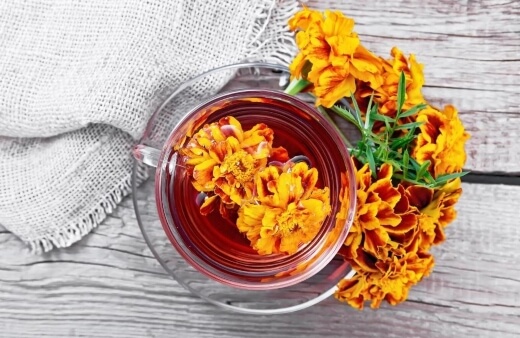
Is the flower of marigold good for skin?
Marigold flowers have been used to treat a variety of skin conditions such as inflammation, sensitivity, redness and dryness. Its essential oil and distilled floral water are used to reduce damage caused by UV radiation and prevent signs of ageing.
Medicinal applications of marigold are used for contusions, bruises and varicose veins. Marigold ointment promotes wound healing for eczema and sunburns.
Is there such a thing as marigold tea?
Marigold tea has many uses. You can drink it three times a day to ease cramps and aid digestion. It helps with nausea, stomach ulcers and menstrual pain. Tincture of marigolds relieves headaches and can help promote good sleep.
What can I do with dried marigolds?
Dried petals can be used in casseroles, breads, and omelettes, to add a unique and subtle flavour to these dishes. You can stir-fry them alone or with vegetables. They're also tasty in rice, soups, stews, and sprinkled on salads.
How do you use marigolds for your hair?
You can add a handful of fresh or dried marigold flowers to three cups of hot water and let it stand for an hour. Strain and cool the water and then use it as a rinse for your hair. It helps with oily hair and promotes body and shine.
Where is the best place to plant marigolds?
Most species of marigold prefer an area with full sun but they can also tolerate some shade. In very hot spells, some afternoon shade will be beneficial. Be sure to also protect your marigolds from strong winds and damaging rainfall.
How long do marigold plants last?
Being annuals, these plants only live for one year. However, many marigolds self-seed quite reliably so they may appear to be perennial when they are just coming back from seed the following year.
What do marigolds keep away?
Known as some of the best insect-repelling plants, marigolds have a scent that will deter pests like mosquitoes, cabbage worms and many other insects. They will also attract many beneficial insects that attack and kill aphids.
Should marigolds be watered every day?
Only water your marigolds when the top 2 to 3 centimetres of soil has dried. Container-grown plants may require more frequent watering.
Do marigold plants spread?
Most varieties self-seed meaning they can spread throughout flower beds and the garden year after year.
Do marigolds do well in pots?
Smaller varieties of marigolds will do well in pots or as edging plants for borders. Even larger marigolds can be grown in containers but you will need to use larger pots for these plants.
Start Growing Marigolds in Your Garden
Marigolds are a flower that really packs a punch. They are the perfect companion plant, helping to protect the garden from microscopic pests and hungry visitors. They are cheerful and abounding in varieties to choose from.
You can make marigold tea, or a marigold rinse for your hair. Or you could just pick them as a delightful bunch of sunshine to brighten up your home. We think marigold flowers are just lovely and we’re giving them our green thumbs up.
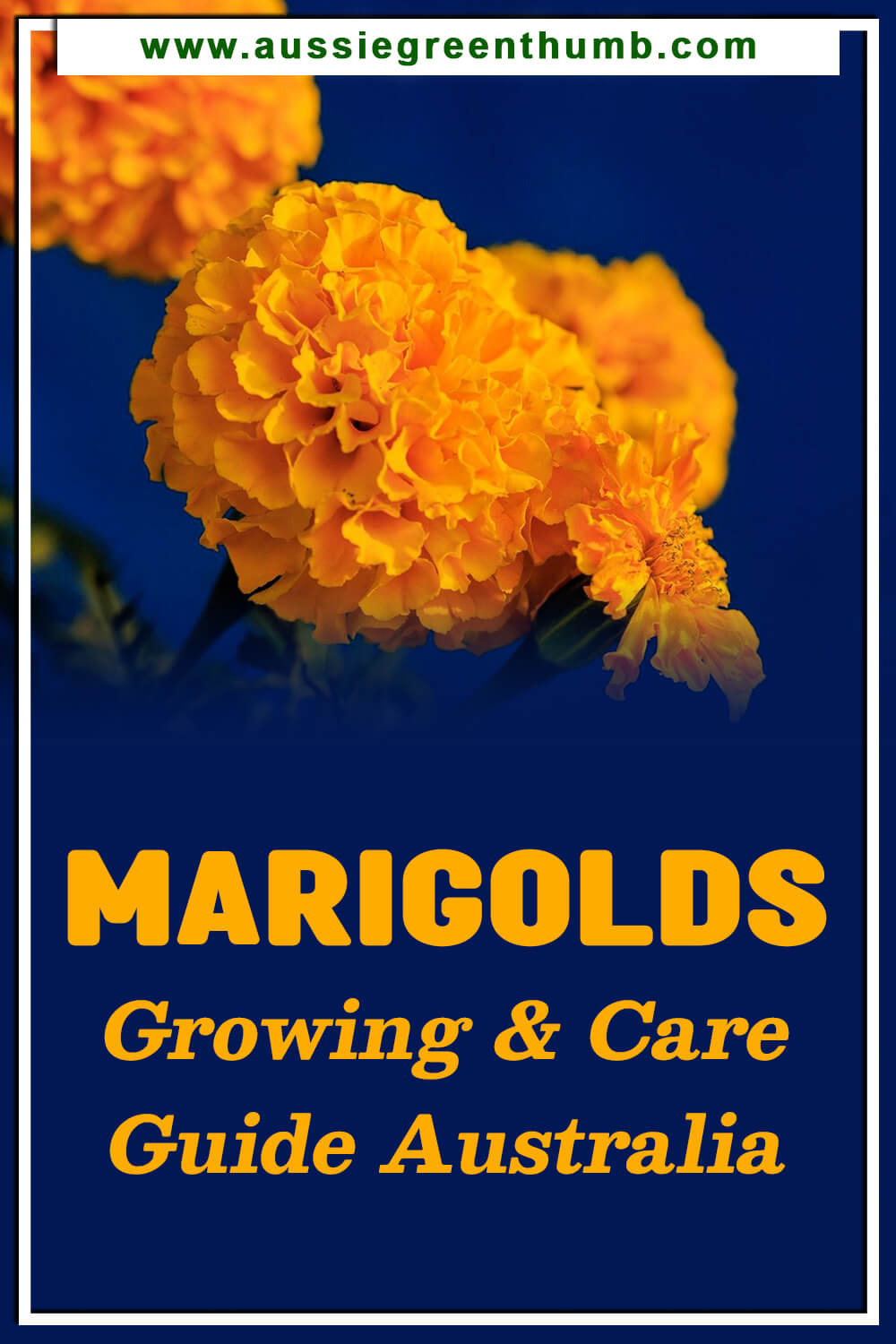
Published on January 5, 2023 by Maisie Blevins
Last Updated on October 4, 2025




